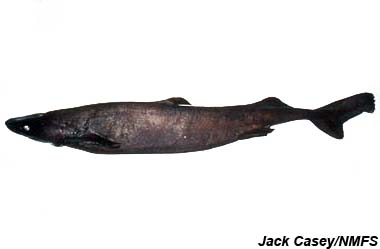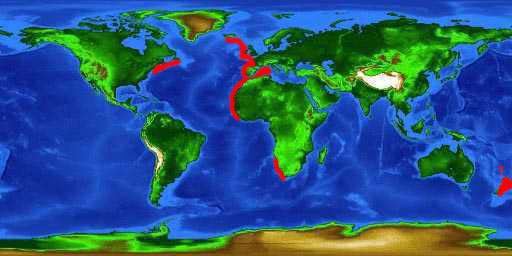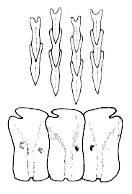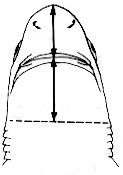
Centroscymnus coelolepis
This small, stout, deep-water shark has small fins set far back towards its asymmetrical caudal (tail) fin. It is a blackish-brown color, with large eyes and mouth. Size can reach a maximum of 120 cm (3.9 ft), but they tend to be found at depths greater than 400 m (1312 ft). Because of their size and deep habitat, they are considered no harm to humans, but they are fished for liver oil and meat.
Order – Squaliformes
Family – Somniosidae
Genus – Centroscymnus
Species – coelolepis
Common Names
- English: Portuguese shark, Portuguese dogfish, and siki shark
- Arabic: kalb
- Czech: ostroun portugalský
- Danish: portugisisk fløjlshaj
- Dutch: portugese ijshaai
- Faroese: glíggjháur
- Finnish: syvänne-piikkihai
- French: pailona commun
- German: portugiesenhai
- Greek: kentroskymnos
- Icelandic: gljáháfur
- Italian: centroscimno
- Japanese: marubara-yumezame
- Portuguese: tubarão português and xara preta
- Spanish: pailona, palluda, rasqueta, and tiburón portugués.
- Swedish: pailonahaj
Importance to Humans
Captured by hook and trawls, mainly as bycatch (Compagno, 1984). They are targeted in Japan and Portugal for their liver oil due to the high level of squalene present (Batista, 1992). In the eastern Atlantic, the flesh is used for human consumption and reduction into fishmeal (Compagno, 1984). However, they are not of commercial importance off the coast of New England in the U.S. (Castro, 2010). They derive their name from having been first described from Portugal (Castro, 2010).
Danger to Humans
This species poses no danger to humans due to its small size and deepwater habitat.
Conservation
Considered “Near Threatened” by the World Conservation Union (IUCN), the Portuguese shark has been commercially exploited in some regions of the world for squalene (Batista, 1992). The productivity of this species is likely to be low (although age estimates and annual fecundity are currently unknown) and further increases in catches should be a reason for concern. Conservation measures include regulations set forth by the South East Trawl Fishery in Australia (2002) which prohibits the landings of livers unless the accompanying carcass is also landed (Vannuccini, 1999).
> Check the status of the Portuguese shark at the IUCN website.
Geographical Distribution

Their range includes the Atlantic, Indian, and Pacific oceans (Compagno et al., 2005). In the Atlantic the distribution is patchy. It stretches from Grand Banks, Newfoundland to New England in the western Atlantic and from Iceland to the Azores and Cape Verde Islands in the eastern Atlantic, including the western Mediterranean (Castro, 2010). In the western Pacific, they are found off China and New Zealand, and in the Indian Ocean, they are around the Aldabra Islands (Compagno, 1984).
Habitat
Portuguese sharks are benthic and live in deep water near the bottom, often on continental slopes or abyssal plains (Compagno et al., 2005). They are captured most frequently at depths below 400m (1312 ft) in Australia they occupy a range of depths from 270 – 3,675 m (886 – 12,057 ft) (Compagno, 1984). The Portuguese shark segregates by size and sex, with mature males tending to be in the lower depths, while mature females inhabit the deepest waters and the immature are found between the two (Veríssimo et al., 2011).
Biology

Distinctive Features
The body moderately stout with a short, blunt snout (Compagno et al., 2005). The mouth of this shark is large with short upper and lower labial furrows (Compagno, 1984, Compagno et al., 2005). The two dorsal fins are similar sizes and heights and have small fin spines. The first dorsal fin origin is posterior to the broadly rounded pectoral fins (Compagno, 1984). The Portuguese shark is also characterized by its lack of an anal fin (Castro, 2010). The upper caudal lobe is much longer than the lower with a deep subterminal notch. There are no lateral keels or precaudal pits present (Compagno, 1984).
This shark may be confused with the Greenland shark (Somniosus microcephalus) or the kitefin shark (Dalatias licha); however, both of these species lack dorsal spines (Castro, 2010).

Coloration
Adults are uniformly blackish to golden-brown, without any obvious markings (Compagno et al., 2005). Juveniles are more black than brown but also uniformly colored (Castro, 2010).
Dentition
The upper and lower teeth are markedly different in shape. The upper teeth are slender and erect with one lanceolate cusp and no cusplets (Compagno, 1984). The lower teeth are very short with oblique cusps, described as bladelike (Compagno, 1984). The teeth of the upper jaw number around 58 while there are about 40 teeth in the lower jaw (Castro, 2010).
Dermal Denticles
Denticles of juveniles have three points and are widely spaced, unlike the adult denticles that are rounded with a rear point and overlap (Castro, 2010). Adult denticles also have a depression in the middle and are clearly visible (Castro, 2010).
Size, Age & Growth
The maximum size reported has been 119 cm (3.9 ft), but most adults are around 90 to 95 cm (2.9 to 3.1 ft) (Compagno, 1984). Maturity for Japanese males is around 70 cm (2.3 ft), but is 90 cm (2.9 ft) for sharks off Portugal. Females mature around 100 cm (3.3 ft), but females have been observed mature as small as 80 cm (2.6 ft) (Castro, 2010).

Food Habits
Benthic invertebrates, bony fishes, other sharks, cetacean meat, and seal meat are all part of the Portuguese shark’s diet (Compagno et al., 2005). However, they have been known to show a preference for cephalopods and bony fishes (Carrassón and Cartes, 2002). They actively scavenge as well, though foraging methods are not well known (Jamieson et al., 2011), but will take live prey as well (Compagno et al., 2005).
Reproduction
Portuguese sharks are ovoviviparous (Compagno et al., 2005). They have low fecundity with 10-14 pups per litter and females have a resting period between gestation periods (Verissimo et al., 2011). At birth, pups have a length of approximately 30 cm (12 in.) (Compagno et al., 2005). Reproduction is thought to occur year-round and active mature males and females are found in the same depth interval (Verissimo et al., 2003).
Predators
Large fish and sharks
Taxonomy
The Portuguese shark was originally described as Centroscymnus coelolepis by Barbosa du Bocage and Brito Capello in 1864. This name is still accepted as scientifically valid. Scymnodon melas is a synonym that has occurred in past scientific literature to refer to this species. The genus name, Centroscymnus, is derived from the Greek “kentron” which means sting and from the Greek “skymnos” which means puppy.
Revised by: Macey Siegel 2020
Prepared by: George Burgess, Cathy Bester
Resources
- Batista, I. and Nunes, M.L., 1992. Characterisation of shark liver oils. Fisheries research, 14(4), pp.329-334.
- Carrassón, M. and Cartes, J.E., 2002. Trophic relationships in a Mediterranean deep-sea fish community: partition of food resources, dietary overlap and connections within the benthic boundary layer. Marine Ecology Progress Series, 241, pp.41-55.
- Castro, J.I., 2010. The sharks of north America. Oxford University Press.
- Compagno, L.J.V., 1984. Sharks of the world: an annotated and illustrated catalogue of shark species known to date, 4(1). FAO species catalogue.
- Compagno, L.J.V., Dando, M. and Fowler, S., 2005. A Field Guide to the Sharks of the World. London, UK: Collins.
- Jamieson, A.J., Fujii, T., Bagley, P.M. and Priede, I.G., 2011. Scavenging interactions between the arrow tooth eel Synaphobranchus kaupii and the Portuguese dogfish Centroscymnus coelolepis. Journal of fish biology, 79(1), pp.205-216.
- Vannuccini, S., 1999. Shark utilization, marketing, and trade(No. 389). Food & Agriculture Org..
- Veríssimo, A., Gordo, L. and Figueiredo, I., 2003. Reproductive biology and embryonic development of Centroscymnus coelolepis in Portuguese mainland waters. ICES Journal of Marine Science, 60(6), pp.1335-1341.
- Veríssimo, A., McDowell, J.R. and Graves, J.E., 2011. Population structure of a deep-water squaloid shark, the Portuguese dogfish (Centroscymnus coelolepis). ICES Journal of Marin